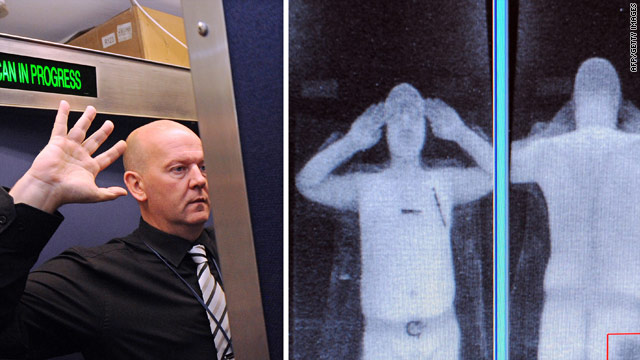Dutch, Nigerians to use full body scans for air travelers
From: http://us.cnn.com/

(CNN) -- The Netherlands and Nigeria will begin using body scanners on airline passengers following the attempted terrorist attack on a U.S.-bound flight on Christmas Day, authorities in both nations said Wednesday.
The millimeter-wave body scanners will be in place at Amsterdam's Schiphol Airport in about three weeks and will be used on all passengers traveling to the United States, Dutch Interior Minister Guusje ter Horst told a news conference at The Hague.
"We've escaped a very serious attack with serious consequences, but unfortunately in this world there are individuals who do not shy away from attacks on innocent people," she said.
Nigeria did not say when it would begin the new scans. "In combating the new threat of terrorism as unfolded recently, Nigeria will be upgrading its security screening system to 3D Total Body Imaging Scanner," the country's airport authority said in a statement. It gave no further details.
Do new rules make you feel safer? Share your airport experiences.
Nigerian suspect Umar Farouk AbdulMutallab, 23, is accused of trying to blow up a Northwest Airlines plane going from Amsterdam to Detroit, Michigan, with explosives that had been concealed in his underwear. He is charged with attempting to destroy an aircraft.
The militant group al Qaeda in the Arabian Peninsula has claimed responsibility for the December 25 plot.
Dutch authorities have already said they were confident in the security measures that were carried out when AbdulMutallab transferred to the Detroit flight from an earlier flight from Nigeria.
A source in Lagos, Nigeria, with connections to the aviation industry told CNN that AbdulMullatab arrived in Nigeria from Accra, Ghana, on December 24. He flew in on a Virgin Nigeria flight, arriving in Lagos about 7:30 p.m. local time (1:30 p.m. ET), about an hour before he checked in for a KLM flight to Amsterdam. He checked one bag, the source said.
 Video: Dutch to use body scanners
Video: Dutch to use body scanners  Video: Netherlands now uses body scan
Video: Netherlands now uses body scan  Video: Inside the X-ray
Video: Inside the X-ray Ter Horst said that security measures in place in Amsterdam were metal detectors and X-ray machines, and admitted they could not have picked up the explosive material that AbdulMullatab was allegedly carrying.
"The introduction of these body scanners would certainly have helped in detecting that he was carrying something on his body," she said. "We know that metal detection does not help to detect non-metal explosives, and these millimeter-wave scanners can do this, which would mean that this would be an improvement."
One passenger on same plane as AbdulMutallab told CNN's "Larry King Live" that the security checks at Schiphol were not as stringent as those she is used to in the United States.
"We walked through and did not have to take our shoes off," said Wisconsin native Richelle Keepman. "Also, my mother had a water bottle in her bag that she'd completely forgotten about. And it went right through and we didn't realize it until we were on the plane."
Ter Horst acknowledged that the systems currently in place are "not watertight," which is why the body scanners are being introduced.
As to privacy concerns -- namely that the scanners could pick up private features of a person's body -- ter Horst said the scan results would first go through a computer, which would then flag any suspicious items to a human.
The scanners will be permanent at Schiphol, and any passengers bound for the United States who do not go through them will be body-searched, ter Horst said.
Erik Akerboom, the Dutch national coordinator for counterterrorism, said part of the investigation is looking at whether the explosives were brought into Schiphol by someone else for AbdulMutallab to pick up later.
Dutch authorities are also looking into whom he was in touch with while at Schiphol awaiting his connecting flight. They are combing surveillance camera footage from the connections hall, Akerboom said.
Asked about reports that AbdulMutallab paid for his ticket in cash and was flying only with hand luggage, Akerboom said neither would have necessarily raised any alarms.
"There are several travelers who do this," he said.
AbdulMutallab's name had come to the attention of U.S. authorities before the attack, sources have told CNN in recent days.
His father talked twice about his son's extremist views with at least one CIA representative at the U.S. Embassy in Nigeria and a report was prepared, but the report was not circulated outside the agency, a reliable source told CNN's Jeanne Meserve on Tuesday.
Had that critical information been shared, the man might have been denied passage on the flight, the source said.
A U.S. intelligence official said AbdulMutallab's name, passport number and possible connection to extremists were indeed disseminated. But the official added, "I'm not aware of a magic piece of intelligence -- somehow withheld -- that would have put AbdulMutallab on the no-fly list."
CIA spokesman George Little defended the agency's actions regarding AbdulMutallab, but also said the agency is reviewing data to ascertain whether more could have been done.
State Department spokesman Ian Kelly said department staff did what they were supposed to by sending a cable to the National Counterterrorism Center in Washington about the matter. Kelly said any decision to revoke the suspect's visa would have been an interagency decision.
Ter Horst said Dutch authorities did not know that AbdulMutallab had raised any security flags, and she called for a global watch list for all suspect travelers in the future.





